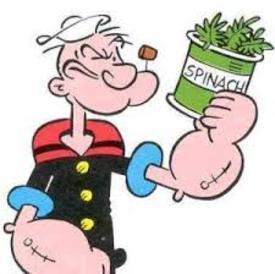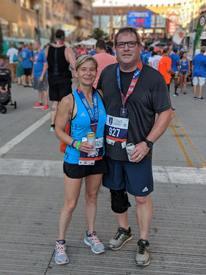Does Delayed Muscle Soreness mean a good workout?

Azdak
Posts: 8,281 Member
New blog posted
http://www.myfitnesspal.com/blog/Azdak/view/does-delayed-onset-muscle-soreness-mean-a-good-workout-584290
I intended this to be a short summary, but as usual, went way too long. Hope you find some useful info:
Delayed onset muscle soreness (DOMS) is something that most exercisers have experienced. DOMS is usually associated with new activity, especially vigorous activity. The exact cause of DOMS is not completely known, but the current consensus is that DOMS is caused by an inflammatory response to microscopic tears to connective tissue in the muscles. The response is a combination of edema, increased sensitivity of nerve receptors, increased pain signals, and a disruption of cellular structure.
DOMS is usually associated with a new type of training stimulus, not necessarily a heavy or more intense load. Eccentric loading of muscles seems to result in a greater DOMS effective, although it can be caused by concentric contractions as well. DOMS is usually noticed 6-8 hours after a workout and is said to peak 48 hours after exercise (although there is wide variability--for many beginners DOMS remains at a peak level 72-96 hours after exercise). As one repeats a certain movement or load, DOMS response reduces significantly or can disappear altogether.
Because DOMS usually occurs after a new movement or routine, many exercisers conclude that the new movement is "better" than what they were doing before. Some people become concerned when they no longer experience DOMS after a workout, wondering if that workout is still effective.
Because of the perception that "soreness = good workout" some exercisers actively try to do workouts that elicit DOMS. Tom Venuto has said on a number of occasions that he doesn't feel he had a quality workout unless he is extra sore the next day and feels it is a psychological boost. (I must also emphasize that Venuto is clear that this is his personal preference, not a general recommendation--his writing on the subject is thorough, balanced, and science-based).
Is DOMS a valid indicator of progress and a quality workout? Brad Schoenfeld and Bret Contreras explored this issue for the National Strength and Conditioning Association Journal. They explored two questions: 1) is Exercise Induced Muscle Damage (EIMD) beneficial for increased training effects and 2) is DOMS a valid indicator that EIMD has occurred?
The article reviews the literature and points out that there is indirect support that EIMD promotes muscle hypertrophy. On a "micro" level, there are a number of responses to EIMD--increases is protein synthesis, increase in stem cells, increased cellular signaling--that are associated with muscle hypertrophy. So, "theoretically", it seems possible that, at least when it comes to muscle hypertrophy, eliciting a EIMD response might have some benefit.
However, as with many exercise topics, saying that something is plausible or "makes sense" does NOT constitute "proof". As of yet, there is no research that supports a direct cause and effect relationship between EIMD and muscle growth. In other words, it cannot be established that these cellular responses occur specifically for the purpose of promoting muscle growth, or if they are just coincidental and can also be elicited by other types of training. It HAS been shown that hypertrophy can occur without EIMD, so it there was any effect, it would likely be more additive than absolutely necessary. In some cases, excessive EIMD can actually hinder training--reducing force production, negatively affecting form, and extending recovery time.
As for the question "Is DOMS a valid indicator of muscle growth", the authors are much more skeptical. While there is some suggestion that EIMD might enhance muscle hypertrophy and that DOMS is a byproduct of EIMD, there is considerable variability in the DOMS response.
MRIs have shown that symptoms of DOMS do not correlate well to the appearance of edema. Humans can experience symptoms of DOMS without any inflammation and there is wide interpersonal variability in the occurance of DOMS following exercise. And, finally, there are types of resistance movements that have been shown to enhance hypertrophy that elicit no DOMS response whatsover.
In summary, the authors concluded that, while there might be some justification for seeking to achieve some EIMD during training in order to maximize hypertrophy gains, the applicabilty of using DOMS to assess workout quality was inherently limited and DOMS should not be used for that purpose.
http://www.myfitnesspal.com/blog/Azdak/view/does-delayed-onset-muscle-soreness-mean-a-good-workout-584290
I intended this to be a short summary, but as usual, went way too long. Hope you find some useful info:
Delayed onset muscle soreness (DOMS) is something that most exercisers have experienced. DOMS is usually associated with new activity, especially vigorous activity. The exact cause of DOMS is not completely known, but the current consensus is that DOMS is caused by an inflammatory response to microscopic tears to connective tissue in the muscles. The response is a combination of edema, increased sensitivity of nerve receptors, increased pain signals, and a disruption of cellular structure.
DOMS is usually associated with a new type of training stimulus, not necessarily a heavy or more intense load. Eccentric loading of muscles seems to result in a greater DOMS effective, although it can be caused by concentric contractions as well. DOMS is usually noticed 6-8 hours after a workout and is said to peak 48 hours after exercise (although there is wide variability--for many beginners DOMS remains at a peak level 72-96 hours after exercise). As one repeats a certain movement or load, DOMS response reduces significantly or can disappear altogether.
Because DOMS usually occurs after a new movement or routine, many exercisers conclude that the new movement is "better" than what they were doing before. Some people become concerned when they no longer experience DOMS after a workout, wondering if that workout is still effective.
Because of the perception that "soreness = good workout" some exercisers actively try to do workouts that elicit DOMS. Tom Venuto has said on a number of occasions that he doesn't feel he had a quality workout unless he is extra sore the next day and feels it is a psychological boost. (I must also emphasize that Venuto is clear that this is his personal preference, not a general recommendation--his writing on the subject is thorough, balanced, and science-based).
Is DOMS a valid indicator of progress and a quality workout? Brad Schoenfeld and Bret Contreras explored this issue for the National Strength and Conditioning Association Journal. They explored two questions: 1) is Exercise Induced Muscle Damage (EIMD) beneficial for increased training effects and 2) is DOMS a valid indicator that EIMD has occurred?
The article reviews the literature and points out that there is indirect support that EIMD promotes muscle hypertrophy. On a "micro" level, there are a number of responses to EIMD--increases is protein synthesis, increase in stem cells, increased cellular signaling--that are associated with muscle hypertrophy. So, "theoretically", it seems possible that, at least when it comes to muscle hypertrophy, eliciting a EIMD response might have some benefit.
However, as with many exercise topics, saying that something is plausible or "makes sense" does NOT constitute "proof". As of yet, there is no research that supports a direct cause and effect relationship between EIMD and muscle growth. In other words, it cannot be established that these cellular responses occur specifically for the purpose of promoting muscle growth, or if they are just coincidental and can also be elicited by other types of training. It HAS been shown that hypertrophy can occur without EIMD, so it there was any effect, it would likely be more additive than absolutely necessary. In some cases, excessive EIMD can actually hinder training--reducing force production, negatively affecting form, and extending recovery time.
As for the question "Is DOMS a valid indicator of muscle growth", the authors are much more skeptical. While there is some suggestion that EIMD might enhance muscle hypertrophy and that DOMS is a byproduct of EIMD, there is considerable variability in the DOMS response.
MRIs have shown that symptoms of DOMS do not correlate well to the appearance of edema. Humans can experience symptoms of DOMS without any inflammation and there is wide interpersonal variability in the occurance of DOMS following exercise. And, finally, there are types of resistance movements that have been shown to enhance hypertrophy that elicit no DOMS response whatsover.
In summary, the authors concluded that, while there might be some justification for seeking to achieve some EIMD during training in order to maximize hypertrophy gains, the applicabilty of using DOMS to assess workout quality was inherently limited and DOMS should not be used for that purpose.
0
Replies
-
Bump to give this one more time around.0
-
Informative and interesting, as always. Thanks!0
-
Great post!0
-
Great, informative post, as usual. Thanks!0
-
Great read...thanks for posting.0
-
Thanks for the insight into the soreness question0
-
Thanks for the clarification. I had never heard of DOMS before but have most definitely been experiencing it the last few days.0
-
I just started a new routine this week and have a nice soreness in some of my muscles. No pain no gain.0
This discussion has been closed.
Categories
- All Categories
- 1.4M Health, Wellness and Goals
- 398.5K Introduce Yourself
- 44.7K Getting Started
- 261K Health and Weight Loss
- 176.4K Food and Nutrition
- 47.7K Recipes
- 233K Fitness and Exercise
- 462 Sleep, Mindfulness and Overall Wellness
- 6.5K Goal: Maintaining Weight
- 8.7K Goal: Gaining Weight and Body Building
- 153.5K Motivation and Support
- 8.4K Challenges
- 1.4K Debate Club
- 96.5K Chit-Chat
- 2.6K Fun and Games
- 4.8K MyFitnessPal Information
- 18 News and Announcements
- 21 MyFitnessPal Academy
- 1.5K Feature Suggestions and Ideas
- 3.2K MyFitnessPal Tech Support Questions






